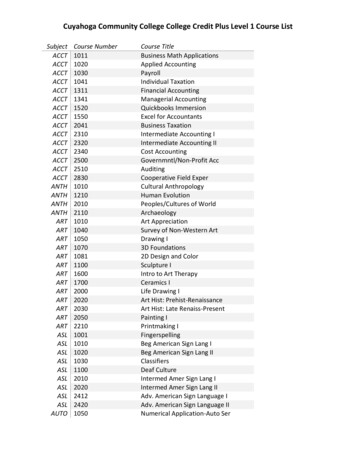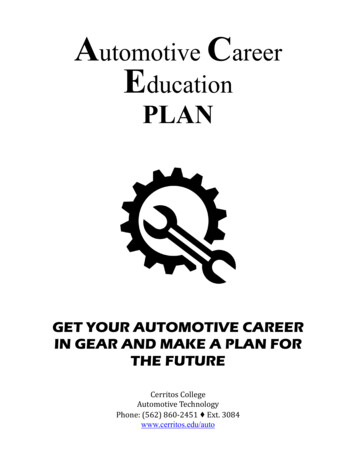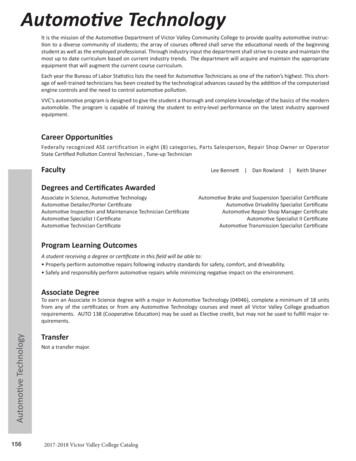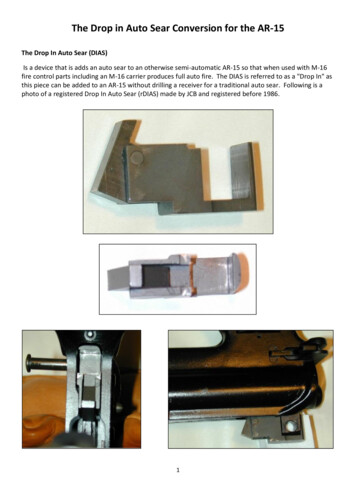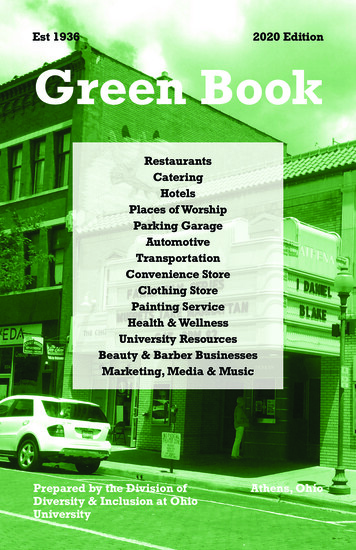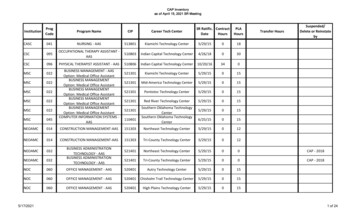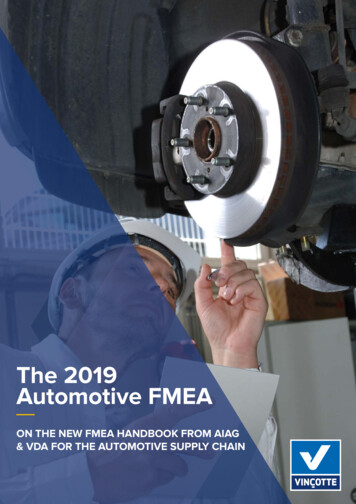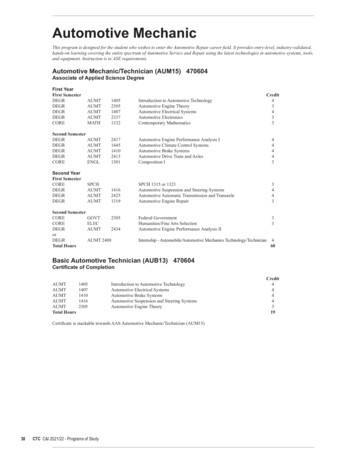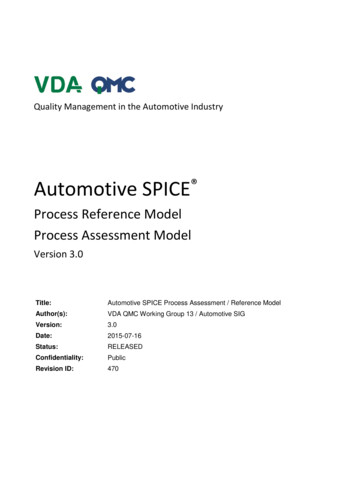
Transcription
Automotive BasicsCareer ClusterPathwayCoursesCareerAUTOMOTIVE BASICSTRANSPORTATION,DISTRIBUTION,& LOGISTICSFACILITY &MOBILEEQUIPMENTMAINTENANCEAUTOMOTIVETECHNOLOGY IMaintenance and Light RepairAUTOMOTIVETECHNOLOGY IIAUTOMOTIVESERVICETECHNICIANAutomotive ServicePRACTICUMPresenter:Michael Gray, Co-Author of Auto UpkeepThis presentation is available at www.AutoUpkeep.com/presentations.
Download this Presentation
Essential Questions What are the requirements for Automotive Basics (Texas§130.447). What curricular materials are available? How does Automotive Basics fit within a completeAutomotive Service Technology training program? What are the essential units in Automotive Basics? What will each student know and be able to do at thecompletion of Automotive Basics (Texas EssentialKnowledge and Skills - TEKS)? How does Automotive Basics fit within the ASEEducation Foundation (formerly NATEF) Model?
A Few Questions to Think About 1. What do your beginning students know when theyfirst enter your program?2. How do you teach this new generation of studentsthe fundamentals of Automotive Technology?
What does your first courselook like now? Discussion
Automotive Basics – Course Description“Automotive Basics includes knowledge of the basic automotivesystems and the theory and principles of the components thatmake up each system and how to service these systems.Automotive Basics includes applicable safety and environmentalrules and regulations. In Automotive Basics, students will gainknowledge and skills in the repair, maintenance, and servicing ofvehicle systems. This study allows students to reinforce, apply,and transfer academic knowledge and skills to a variety ofinteresting and relevant activities, problems, and settings. Thefocus of this course is to teach safety, tool identification, propertool use, and employability.”Source: /ch130p.html
Resources for Automotive BasicsTexas Education Agency –TEKS §130.447. AutomotiveBasics can be viewed 130/ch130p.htmlTexas CTE Resource Centerincluding Scope andSequence and Lesson asicsTEKS – Auto UpkeepCorrelation Matrix:http://www.autoupkeep.com/standards
Curriculum DesignStep 1Identify DesiredResultsTEKS ASEEducationFoundationTasksStep 2Step 3DetermineAcceptableEvidencePlan LearningExperiences andInstructionASE/End ofProgramTestsCurricularMaterials andLearningActivitiesAdapted from Wiggins and McTighe - Understanding by Design framework.
Enduring UnderstandingsPriority 3Worth Being Familiar WithImportant to Know and DoPriority 2ASE EducationFoundationRequirementsP-3 Tasks 50%P-2 Tasks 80%EnduringUnderstandingPriority 1AutomotiveBasicsP-1 Tasks 95%Central to discipline.Has long lasting value beyondthe classroom.Students revisit these duringtheir lifetime.Adapted from Wiggins and McTighe - Understanding by Design framework.
Rigor/Relevance ComprehensionKnowledge/AwarenessAdapted from International Center forLeadership in EducationAPPLICATION
How is Automotive Basics rigorous? Automotive Basics is Rigorous –– Students: Learn in the Cognitive (knowledge), Affective (attitudes),and Psychomotor (skills) domains. Think and work. Apply knowledge across disciplines. Apply knowledge to real-world predictable situations(e.g., change oil, rotate tires, check tire pressure, periodicinspections, check fluid levels). Apply knowledge they learned to real-worldunpredictable situations (e.g., burned out headlight, deadbattery, flat tire, burst radiator hose, car stuck).
The Future is Bright for Automotive Basics Did you know – 80% of vehicles needservice, fluids, orreplacement parts(Car Care Council, 2017)– 11.6 years old is theaverage age of carsand trucks in the USACommon Vehicle on the Road TodayIs Over 11 Years OldHas 139,000 MilesNeeds Service(IHS Markit, 2016)References:HIS Markit. (2016). Vehicles Getting Older: Average Age of Light Cars and Trucks in U.S. Rises Again in 2016 to 11.6 Years, IHS Markit Says. [Press Release]. Retrievedfrom -trucks-us-rises-again-201Car Care Council. (2017). Community Car Care Events Show Most Vehicles Need Service. [Press release]. Retrieved Car-Care-Events-Show-Most-Vehicles-Need-Service
Uninformed Consumershttps://www.youtube.com/watch?v MWdmD1jF8awhttps://www.youtube.com/watch?v IOooYBJWBa4What happens when you don’t change the oil as required?
What is Auto Upkeep? Was developedbecause most textsare either toocomplex or too simpleto teach anAutomotive Basicscourse.
Think of it this way 1500 Pages Comprehensive Automotive Technology Textbook Includesa lot of “Worth Being Familiar With” InformationBest Suited for MAST ProgramsAuto Upkeep 288 Pages Best Suited for Automotive Basics/MLR ProgramsInformation Central to Discipline, Long Lasting Value Beyond the Classroom
What’s special about Auto Upkeep? Short, concise chapters12 point font – Easy-to-Read3 Levels of headings when necessaryA figure, picture, or graph accompanies almost everyblock of textHelpful emphasis blocks – Tech Tips, Price Guides, WebLinks, Servicing, Trouble Guides, Activities, Q & A’s,Career Paths, CalculationsVideos, Apps, and QR Codes to extend learning onlineReviewed by young adults and technical reviewersExtensive effort was put on book layoutHands-on and Internet-based activities (40 activities inall)
What are the Auto Upkeep units?1.2.3.4.5.6.7.8.9.10.Introduction and How CarsWorkBuying an AutomobileAutomotive ExpensesRepair FacilitiesSafety Around theAutomobileTools and EquipmentAuto Care and CleaningFluid Level CheckElectrical SystemLubrication System11.12.13.14.15.16.17.18.19.20.Fuel SystemCooling System and ClimateControlIgnition SystemSuspension, Steering, and TiresBraking SystemDrivetrainExhaust and Emission SystemAlternative Fuels and DesignsAutomotive AccessoriesCommon Problems andRoadside Emergencies* 40 hands-on and internet-based activities engage the students
How is Auto Upkeep commonlydelivered? Auto Upkeep was designed to have a balancebetween in-class and hands-on instruction.– Commonly two days a week are in-class and threedays a week are in the automotive lab.– Curriculum is flexible for you to adjust it to fit yourspecific situation.
What will each student know and be ableto do at the completion of Auto Upkeep? Automotive Basics TEKS – 100% Competencies – Over 200 Over 60% of ASE Education Foundation Maintenanceand Light Repair (MLR) Tasks – making it an ideal firstcourse.» www.AutoUpkeep.com/standards/
Instructor USB – Turn Key Curriculum orModify it as YOU Want Sample Course Syllabus OutlinePowerPointsCompetency ProfileMLR Correlation MatrixTEKS Correlation MatrixTests and Exams– Available as PDFs, MS Word Docs, and as a Common CartridgeFile for your Learning Management System (Canvas, Blackboard,etc.) Lab Activities Study Questions Answer Keys
QR Codes for Each Chapter
App to Extend Learningwww.AutoUpkeep.com/app/
Video Site with Over 100 Videoswww.Video.AutoUpkeep.com
Online Chapter Resourceswww.AutoUpkeep.com
Who’s using Auto Upkeep? Over 500 secondaryand post-secondaryschools throughoutthe United States andCanada Large schools inTexas to smallschools in Wisconsin Over 100,000 copiessold since inception Now in the 4th Edition
How does Auto Upkeep, ASEEducation Foundation’s MLR Tasks,and Automotive Basics fit together?
ASE - Tasks/HoursASE Education Foundation ModelMAST – 439 tasks at 1200 hours (Includes MLR and AST)AST – 353 tasks at 840 hours (Includes MLR)MLR – 218 tasks at 540 hours
What is a Task? “A task is a psychomotor or cognitive entry-levellearning activity consisting of one or moremeasureable steps accomplished through aninstructor presentation, demonstration,visualization or a student application.”» Obtained from the ASE Education Foundation - http://aseeducation.org/resources– It should be noted that each task is not dedicated anhour allotment some tasks take longer than others.
ASE Education FoundationAssumptions “Individual courses of study will differ acrossautomobile technician training programs” “Development of appropriate learning deliverysystems and tests which monitor studentprogress will be the responsibility of theindividual training program”» Obtained from the ASE Education Foundation - http://aseeducation.org/resources
Basically TEKS lists the required knowledge and skills. The ASE Education Foundation provides therequired tasks and hours. YOU provide the program course structure,curriculum, and student materials.
Questions?
To Get Free eBook AccessSign-Up on the Sign-In Sheet and I will email youan eBook access code.
Contact InformationMichael GrayRolling Hills omwww.AutoUpkeep.comEmail: info@autoupkeep.comLinkedIn – www.LinkedIn.com/in/MichaelEGrayTwitter – www.Twitter.com/AutoUpkeepVideos – www.Video.AutoUpkeep.comYouTube – www.YouTube.com/AutoUpkeepFacebook – www.Facebook.com/AutoUpkeep
Automotive Basics - Course Description "Automotive Basics includes knowledge of the basic automotive systems and the theory and principles of the components that make up each system and how to service these systems. Automotive Basics includes applicable safety and environmental rules and regulations. In Automotive Basics, students will gain
